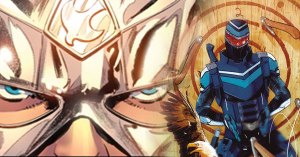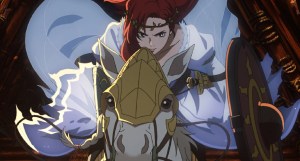Last week, Boom Studios launched the Boom Direct Reserve crowdfunding campaign for . The 12-issue series is the culmination of The Amory Wars. Boom launched the campaign to coincide with the 20th anniversary of the release of the album Good Apollo, I’m Burning Star IV, Volume Two: No World for Tomorrow, as the comic adapts that portion of the larger The Amory Wars story, its grand finale.
Boom set an initial funding goal of $25,000 and achieved it almost instantaneously. A week later, the campaign has raised more than $750,000. In an interview over Zoom, Sanchez tells ComicBook.com that he finds the response encouraging after becoming frustrated with The Amory Wars‘ distribution to comic shops and bookstores.
Videos by ComicBook.com
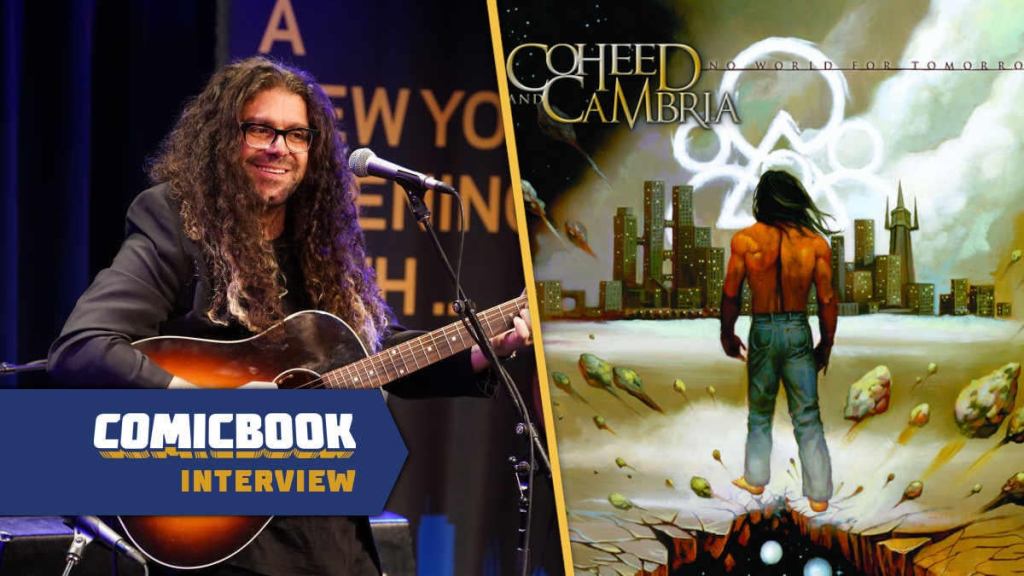
“I feel great,” Sanchez says from his home, having recently returned from Coheed and Cambria’s latest round of tour dates. “It’s nice to see this sort of reception in any arena. What I love about it is that it quantifies the excitement. This is something I talk about a lot is, I go into retailers all the time, and whether they’re my local comic shop or a Barnes and Noble, I never see The Amory Wars. Maybe 5% of the time I might stumble upon In Keeping Secrets. For me, this sort of situation is a way to quantify that excitement to maybe educate retailers that there is an interest in this title that they might not necessarily know about. A lot of our distribution is direct to consumers. We take all our titles, whether they’re related to the Coheed and Cambria arc or not, out on the road with us, and they are so welcomed in that arena that sometimes it’s hard to see that excitement from anywhere else. And so, this is a way to do that and that excites me.”
I joke that becoming frustrated with comic book distribution is a telltale sign that he’s become as much a comic book creator as a rock star. He accepts the notion with pride.
“That makes me feel so good because, for years, I’ve been such a fan of the medium,” he explains. “There were moments where I would get upset when I would see, this is years and years ago, a movie star decides to break into comics. I’m like, ‘Oh, well, they see it as either a stream of revenue or an easy way to try to pitch a movie,’ because when I started doing this 20-some-odd-years ago, the Marvel movies weren’t a thing. When some of the fanbase found out that Coheed and Cambria had a concept with it and it was a comic book concept, we probably lost some fans because, at the time, some people thought comic books weren’t for adults, if you will. So, to see that I’m still doing it and now to see it’s become a thing, companies taking other musicians’ IPs and making them, it’s a little bit of a stretch, but know what I mean? I feel like I had a hand in that. But I’ve always respected the medium so much that I would get this distaste, and now it’s become a thing that everybody’s doing.”
Sanchez and I spoke for a while about what it means to finally complete The Amory Wars in comics, plans for the prequel Year of the Black Rainbow, and the future of The Amory Wars with the ongoing Vaxis pentalogy. That conversation follows.

Do you feel like the excitement that’s infusing this campaign transcends comics? Do you feel like you can point to this and be like, “Look at how excited people were for this comic. Why don’t we make an animated miniseries or short film or whatever?” Do you feel like that excitement goes beyond?
I think so. At one point, the Coheed audience started this petition to adapt The Amory Wars, whether it be a live-action or an animation. Coheed — and myself — didn’t necessarily want to back it, put the Coheed and Amory Wars machine behind it. We let it do its thing and let the audience build it, but this is an extension of that. Yes, I think it does. I think it’s a way for people to see it because, like I said, I go into retail and it has no presence, absolutely none, and it’s upsetting. I know the fever for the title. I’ve done comic conventions now for almost 20 years, probably over 20 years when I think about it. Our first comic convention, I think, was in 2003, 2004, at San Diego.
Just like the band, it’s always been this grassroots, DIY mentality, and it’s grown and grown and there’s an excitement that continues to grow. We never stop selling the books. When we’re on the road, I’m like, “At some point, these books are going to stop selling.” But no, they don’t because the audience grows and the interest in the concept grows.
I’m thrilled because, in a way, like I said, it kind of quantifies the excitement because in other arenas, we can’t. We don’t SoundScan, like a record, the books that we sell on the road. I guess you could see what we’ve printed and then get that number, but it’s too much work. We’re in a rock band.
How has the crowdfunding experience been? Seeing the success you’ve had here, could you see yourself returning to a crowdfunding model for other projects? Amory Wars , for example, or something like that?
Possibly. It’s always been a thing that’s been brought up to me, and the only time it’s made sense is in this moment because again, I wanted a number. I wanted something that people could see to help take the story seriously. When it was first pitched to us, it was a different situation, but as the idea evolved, it became something that wasn’t the right time to do. But being that it’s the 20th anniversary for this arc being the conclusion of the Coheed and Cambria portion of the story, it made sense to do this. And again, it helped me get the number that I was looking for.
But the idea that I would love to do is something that we’re still toying with and potentially, maybe, we’ll come back to a crowdsource situation, but we’ll see. Again, this wasn’t my idea, it was Boom’s, and I just saw an avenue to get something else out of it.
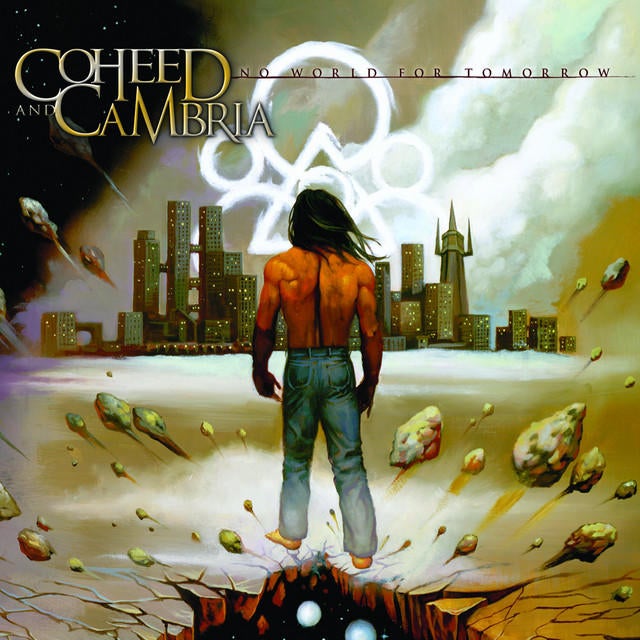
It’s been five or six years since the first volume of Good Apollo finished. You’ve been living with this story for a very long time, but how long has it been since you started working on page one, panel one of the script for the No World for Tomorrow comic?
Oh, that’s a great question. It’s been a couple of years, my wife and I, because at the time we were also juggling the stories that accompany the new records that we’re putting out that are a part of The Amory Wars story arc, the Vaxis pentalogy. There’d be moments where we would get into scripting No World, but then we’d get pulled away from that and then move into drafting the novellas that would accompany those records. And the same goes for right now. We’ve had all 12 issues scripted for a while, but I like to go back and refresh for continuity. And so, we’ve gotten halfway through the scripts and now we’re at #7-12 and Vaxis III is now becoming a reality, so we’re shifting over to that and outlining that story. But we’ve had it now for some time, I almost want to say three or four years, but at least the outline’s been around for quite some time because it’s always something that you’re thinking about as you’re piecing together the other parts.
What form is it in now? The BackerKit isn’t entirely clear about the state of the art. I think Rags Morales’ name appears on some of the placeholder covers and then other ones say “Artist TBA.” Are you waiting to get the funding to then put the artist to work, or is it already basically done? Where’s it at this point?
Before the BackerKit, we started moving into illustrations, and we got three issues deep — pencils, inks – and they’re great, but at the same time, as we were looking at it objectively, we saw an aesthetic that didn’t match with what had happened previously in the book, so we had to put it to a halt. In that respect, we have three issues illustrated, but now we’re going back to square one.
Right now, I think today, we choose our interior artist. But again, that’s the thing, we get all of these samples and everyone is great but it just needs to be right and fit in the mold of what we’ve already created with the previous stories. I think we’re just about there. Once that happens, illustrating will happen immediately after.
No World for Tomorrow has stood for a while as the one part of The Amory Wars without a companion, meaning no comic and no novella to tell the story. And so, fans have been interpreting what exactly the lyrics mean for the past 20 years. Does that add extra pressure to crafting this particular comic, or does it feel more like, finally, it’s all going to be out there?
It is a little stressful because yeah, you want to find that happy medium where the lyrics converge with continuity of stories previously. You want to tie everything up. I think we did a good job, Chondra and I. I’m so thrilled with this story because it does have a little bit of everything for if you’re a fan of The Amory Wars, and I mean from the novel of Year of the Black Rainbow. This is going to be such a payoff because there are a lot of cool surprises. There are a lot of cool things that get tied up, and there are enough questions and answers in this that I think are compelling and thrilling and it’s going to make for a great end. I’m so very excited for it to come out.
We just did a cruise. Coheed now has this thing that we’re doing, it’s now becoming this biannual thing. This was our second year, and The Amory Wars has a big presence on it. We had characters dressed up from the story — Gibney, Mayo, the Crowing, Wilhelm Ryan, and so on – but one of my favorite parts of the cruise was my wife had this coffee hour in the mornings. She does it twice on the cruise, and the second day they did a reading of issue one of No World for Tomorrow, and she did it with her friend Gina. I had so much fun listening to them read this comic and do the voices. It got me excited. I don’t know why I just kind of went into that detour.
I will note that audio drama, and scripted podcasts, are burgeoning mediums if you’re looking for somewhere else to put The Amory Wars.
Right. And my wife, she does one, and we talked about, “Maybe we should do this, maybe the two of you, and I can sit there and chime in every once in a while.” Because I enjoyed it so much. Like so much so that I was supposed to be pulled away to do something, and I was like, “Can we please, I just want to watch this.”
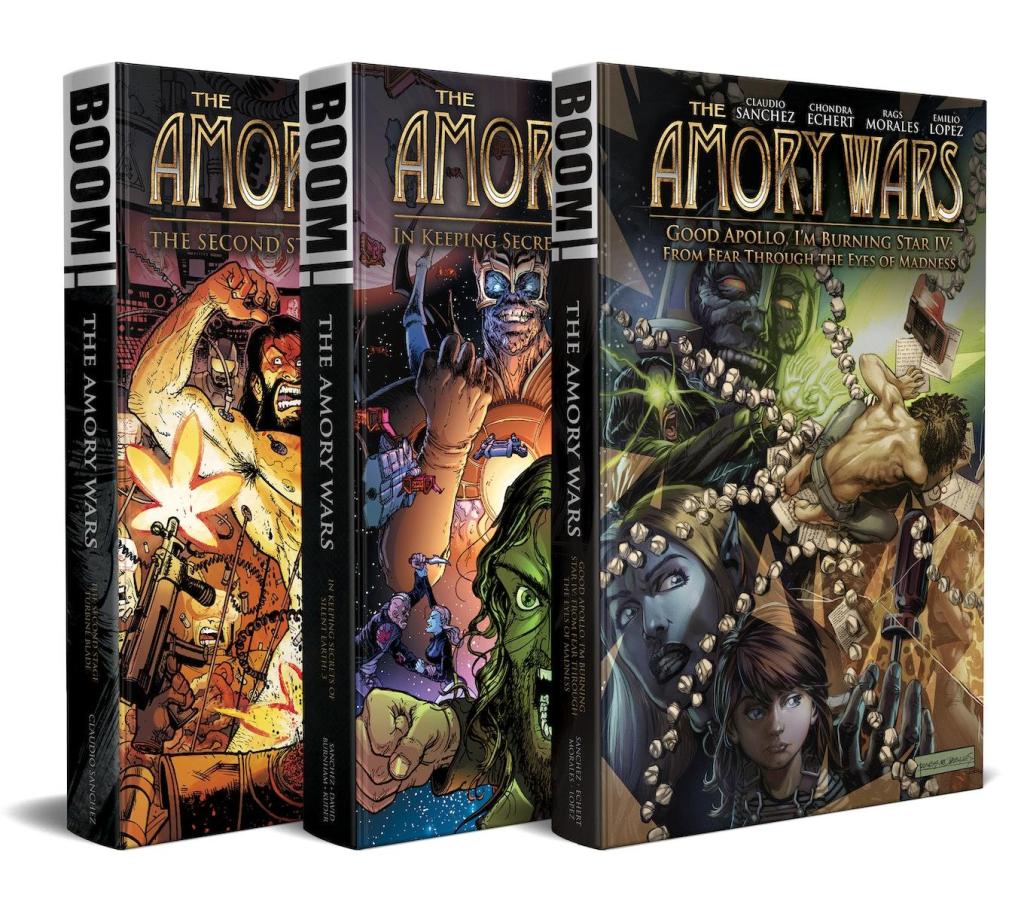
You mentioned Year of The Black Rainbow. This story is the finale of The Amory Wars, but the BackerKit also calls it the penultimate chapter. Not to get too ahead of ourselves, but is that an indication that you want to go back and turn Year of the Black Rainbow into a comic also, even though that novel already exists?
Yeah, absolutely. I don’t think I’m spoiling anything. I’ve said I think it needs that treatment because, ultimately, one of the ideas I’ve had, and maybe this goes with the original idea or the evolved idea before it became The Amory Wars 20th Anniversary Edition is in the story of The Amory Wars, there’s a bible that talks about this riddle and the coming of the Crowing, which is God’s hand that’s there to destroy all of Heaven’s fence, which is the solar system, which the story plays out on, and it’s called the Ghansgraad. I would love to do something called “The Ghansgraad Edition” where we collect all the stories, one through five, Year of the Black Rainbow to No World, and do something really special. I remember as a kid, and I’m not all that religious, but my mother had this enormous Bible, and that’s the thing that plays out in my head is some compartment that houses all these additions in this ornate rendition of the Ghansgraad.
That gets me wondering about Year of the Black Rainbow, which is a prequel, and then there’s stuff like The Afterman, and then Vaxis is a sequel. For somebody who’s trying to enjoy The Amory Wars story, do you recommend going in chronological order, or even starting as far back as The Afterman, or are you a release order person? This is a very George Lucas question, but also, is there a difference depending on if they’re reading the story or listening to the albums, since the albums have the added factor of Coheed and Cambria’s progression as band? What is your definitive order to experience the story?
When I started the idea in ’98, it was like, “Oh, I’m a Star Wars fan.” So, to me, the idea of the prequel was such an interesting thing, so I was like, “I’m going to start with Part 2, and we’re going to go back and tell the origin of the characters, Coheed and Cambria.” And that was a mistake [laughs] because Second Stage without the legs of Year of the Black Rainbow can be confusing. If you don’t suspend disbelief, you’re like, “What the hell is this?” But there’s enough interesting stuff in there, clearly, that it’s gathered its following that’s super invested in it. As much as I find it maybe wasn’t the right thing to do, there’s something right about it.
I would say Second Stage, but if you could get your hands on Year of the Black Rainbow, I would say Year of the Black Rainbow is 1, and that’s the fun part. I’ve said this in the past, but every story has some sort of numeric value to it — “Year” being singular, that would be Part 1, Second Stage, 2, second, In Keeping Secrets of Silent Earth: 3. So there is a numeric order placed, not vaguely, but in an interesting way in the stories. If you can get your hands on Year of The Black Rainbow, I would suggest Year of the Black Rainbow, but if you’re into being perplexed, I would start with Second Stage Turbine Blade.

Has your experience working on the comics affected your approach to how you present some of the newer music? I’ve noticed that the Vaxis music videos, they’re visual, they’re direct, they use some art from the books. Are those videos fulfilling a similar purpose to what the comics do for the previous Amory Wars albums, or is it just something cool and new for you guys to do, and maybe eventually you’ll do comics for those? Is there a creative feedback cycle there?
I think when we were younger, we tried to incorporate the comics into the videos. “Devil in Jersey City” was the first time we tried to incorporate Coheed and Cambria, and it worked for that moment, but I think at the time, as a band, this was my idea, and I’m not so sure everybody else was on board at that time. It felt a little uncomfortable to try to force those sorts of elements in every output we did. I didn’t want to make anyone else feel uncomfortable, and I knew that I did. But I think as time went on and the strength of The Amory Wars grew and the excitement for characters, one can only be so lucky to find an audience that finds a character in a story that they’ve created and bonds with that character, and that’s what The Amory Wars is doing. I think at that point it’s like, “Oh, well, it’s not such a bad idea to incorporate this stuff in a visual way with the music.”
It’s fun. There are moments where it is literally a representation of what happened in the story, but then there are some moments that aren’t, like for example, “Old Flames” was really kind of a play on the characters and me being the creator and a part of their crew. There are little ways to play in the sandbox, but also you’re not totally pushing it where we’re trying to make the full-on adaptation in this three to four-minute exercise, if that makes any sense.
You talked about how you’d bounce back and forth between scripting No World for Tomorrow and making the story for Vaxis. Is it tricky trying to go back and forth between working on this story that you conceived of 20 years ago and then coming back to this new story that you’re working on? Is there a challenge in that or is it pretty easy to keep the two separated?
It’s challenging, but I love it because it helps remind myself, and my wife, of things that we can then connect, try to be cognizant of the thread. We’re not sharing these moments with characters from the Coheed Amory Wars, in the atmosphere, maybe there’s a way to do that. You’re reminded of these things, and I think it’s fun.
I think I had said in a little interview that I did for Boom that what makes No World so exciting to see now come out is its connection to subsequent stories like Vaxis III and the first story, Year of the Black Rainbow, as well as the connection to The Afterman because the last record has that Incredible Hulk #180 ending, where you have the Wolverine silhouette in the doorway, but this is the Afterman making an appearance at the end of Vaxis II in a very Wolverine fashion — though not a silhouette, you see him but it feels like that to me. All these stories are now going to make so much sense when they come out once No World starts and Vaxis III happens, and with the idea of adapting Year of the Black Rainbow, everything is going to connect so much more than it’s ever before. That’s thrilling to me because it’s going to be a domino effect of “this is all making so much sense to me” and I can’t wait to see how it ends with Vaxis IV and V.
I’d be remiss if I let you go without asking, generally, what’s next for Coheed? I know you said you’re working on Vaxis III. What should fans be looking forward to next?
Vaxis III is very much percolating as well and next year we’ll probably do some preliminary touring that’ll lead to a release. I’m not sure exactly when that release is, because there still is a lot of work to do in terms of recording it and illustrating the novella. We’ve started down those paths, but they take some time, as well as writing the novella, of course. Things are going to happen hopefully in the next year or so.
The Amory Wars: No World for Tomorrow crowdfunding campaign continues on BackerKit through the month of November. This interview has been edited for clarity and length.

